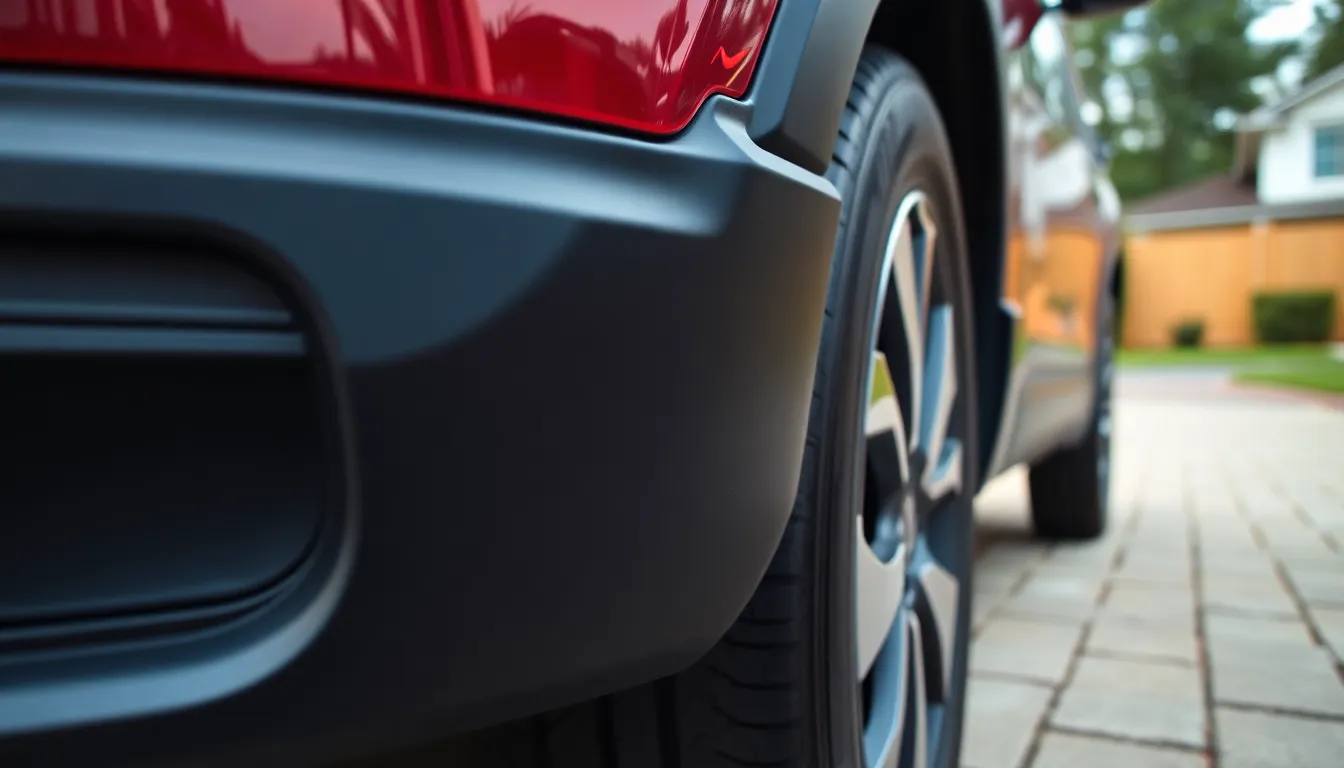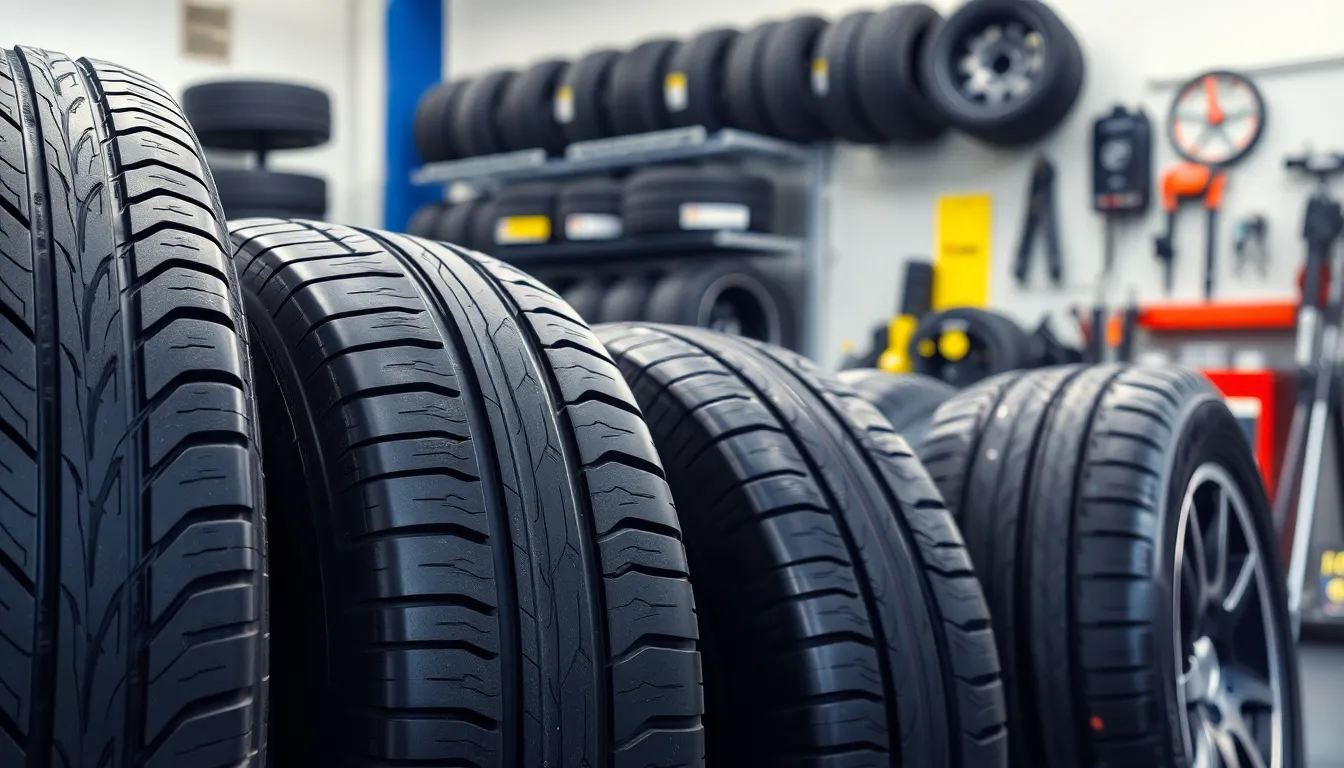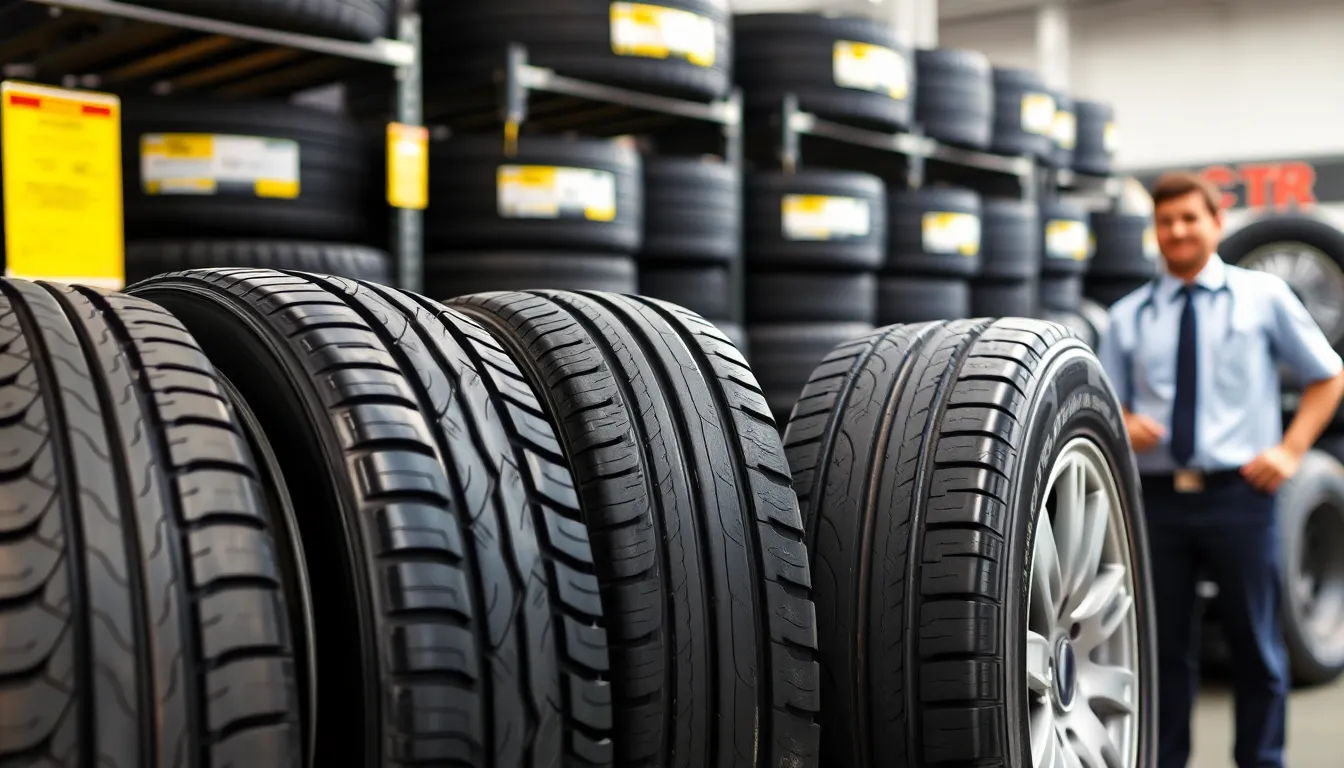We’ve all been there – staring at our Honda CR-V’s tires wondering if we’re running the right size or if it’s time for an upgrade. Choosing the correct tire size isn’t just about aesthetics; it directly impacts your vehicle’s performance, fuel efficiency, and safety on the road.
Your Honda CR-V deserves the perfect tire setup, and we’re here to guide you through everything you need to know. From understanding those cryptic numbers on your sidewall to exploring factory specifications across different model years, we’ll help you make an well-informed choice that keeps you rolling smoothly.
Whether you’re replacing worn tires or considering a size change for better performance, getting the tire size right is crucial for your CR-V’s optimal handling and longevity. Let’s jump into the specifics that’ll transform your driving experience.
Honda CR-V Tire Size by Generation
Honda CR-V tire sizes have evolved significantly across six generations. Each generation introduced exact tire dimensions that match the vehicle’s design and performance requirements.
First Generation (1997-2001)
First generation Honda CR-V models came equipped with 205/70R15 tires as standard equipment. These 15-inch tires provided adequate ground clearance and ride comfort for the compact SUV’s initial design. Higher trim levels occasionally featured 16-inch wheel options with 215/65R16 tires for enhanced handling characteristics.
Second Generation (2002-2006)
Second generation CR-V vehicles maintained the 205/70R15 tire size for base models. EX trim levels upgraded to 215/65R16 tires mounted on 16-inch alloy wheels. This generation marked the beginning of Honda’s transition toward larger wheel diameters for improved road feel and aesthetic appeal.
Third Generation (2007-2011)
Third generation Honda CR-V models standardized 215/65R16 tires across most trim levels. Special Edition and higher trims featured 225/65R17 tires with 17-inch wheels. This generation introduced wider tire profiles that enhanced cornering stability while maintaining ride comfort.
Fourth Generation (2012-2016)
Fourth generation CR-V vehicles came with three primary tire size options. Base LX models used 215/70R16 tires while EX and EX-L trims featured 225/65R17 sizes. Touring models equipped with 18-inch wheels used 235/60R18 tires for premium road performance.
| Trim Level | Tire Size | Wheel Size |
|---|---|---|
| LX | 215/70R16 | 16″ |
| EX/EX-L | 225/65R17 | 17″ |
| Touring | 235/60R18 | 18″ |
Fifth Generation (2017-2022)
Fifth generation Honda CR-V models expanded tire size options across four configurations. LX trims used 215/70R16 tires while EX models featured 225/65R17 sizes. EX-L and Touring trims came with 235/60R18 and 235/55R19 tires respectively. Hybrid models specifically used 235/60R18 tires regardless of trim level.
Sixth Generation (2023-Present)
Sixth generation CR-V vehicles offer three distinct tire size configurations. EX models use 225/65R17 tires while EX-L trims feature 235/60R18 sizes. Sport and Sport Touring models come equipped with larger 235/55R19 tires for enhanced performance and visual appeal.
Understanding Honda CR-V Tire Size Numbers

Honda CR-V tire specifications follow a standardized format that appears on every tire sidewall. We can decode these numbers to understand exactly what fits our vehicle and why each component matters for performance.
Reading Tire Size Specifications
The example 235/60R18 103H represents the standard tire size for many CR-V EX, EX-L, Sport, and Hybrid models. This alphanumeric code appears on the tire sidewall and contains five distinct components that specify the tire’s dimensions and capabilities. Other common CR-V sizes include 235/65R17 for LX models and 235/55R19 for Sport Touring or top trims.
Earlier model years and base trims use smaller sizes such as 215/70R16 or 225/65R17. Each specification follows the same universal format across all U.S. vehicles, making it consistent regardless of the Honda CR-V generation we own.
What Each Number Means
| Component | Example | Meaning |
|---|---|---|
| Width | 235 | Tire width in millimeters from sidewall to sidewall |
| Aspect Ratio | 60 | Sidewall height as percentage of tire width (60% of 235mm) |
| Construction | R | Radial construction tire (standard for modern vehicles) |
| Rim Diameter | 18 | Wheel rim diameter in inches |
| Load/Speed Rating | 103H | Load index (103) and speed rating (H = 130 mph maximum) |
235 indicates the tire width measures 235 millimeters from one sidewall to the opposite sidewall. 60 represents the aspect ratio, meaning the sidewall height equals 60% of the tire width. R designates radial construction, which describes how the tire’s internal layers are arranged.
18 specifies the wheel rim diameter in inches that accommodates this tire size. 103H combines the load index and speed rating, where 103 indicates the maximum weight capacity and H designates a 130 mph speed rating limit.
Tire size specifications always display in this exact order and format on U.S. vehicles. We must verify the correct size for our exact CR-V model and year before purchasing replacement tires to ensure proper fitment and performance.
OEM vs Aftermarket Tire Options

Understanding the differences between original equipment manufacturer tires and aftermarket alternatives helps Honda CR-V owners make informed decisions about replacements and upgrades.
Original Equipment Manufacturer Specifications
Honda designs CR-V tire specifications to match each model’s intended performance characteristics and safety requirements. The 2023 and 2022 models come equipped with three distinct tire sizes depending on wheel configuration: 235/65R17 104H for 17-inch wheels, 235/60R18 103H for 18-inch wheels, and 235/55R19 101H for 19-inch wheels.
Earlier model years feature different OEM specifications that reflect Honda’s evolving design philosophy. The 2016 CR-V EX, EX-L, and SE models use 225/65R17 tires, while Touring models receive larger 225/60R18 tires for enhanced handling. By 2017, Honda expanded options with EX and EX-L models often equipped with either 235/60R18 or 235/55R19 tires based on trim level selections.
| Model Year | Trim Level | OEM Tire Size |
|---|---|---|
| 2022-2023 | 17-inch wheels | 235/65R17 104H |
| 2022-2023 | 18-inch wheels | 235/60R18 103H |
| 2022-2023 | 19-inch wheels | 235/55R19 101H |
| 2016 | EX/EX-L/SE | 225/65R17 |
| 2016 | Touring | 225/60R18 |
| 2017 | EX/EX-L | 235/60R18 or 235/55R19 |
Alternative Tire Size Options
Aftermarket tire choices provide opportunities for customization but require careful consideration of compatibility factors. We recommend maintaining OEM tire sizes for optimal vehicle performance and safety, though some owners pursue different sizes for exact driving needs like off-road capability or enhanced performance characteristics.
Changing tire sizes affects speedometer accuracy, fuel efficiency, and handling dynamics in ways that Honda didn’t engineer for your exact CR-V model. Alternative sizes must maintain similar overall diameter to preserve proper clearance and avoid interference with suspension components or wheel wells.
Critical compatibility factors include wheel dimensions, PCD (pitch circle diameter), offset measurements, and bolt patterns when selecting aftermarket options. Tire pressure recommendations typically range from 33 to 36 psi depending on load conditions and driving requirements, though we always recommend checking your vehicle’s exact placard for manufacturer recommendations.
Regular maintenance becomes even more important with aftermarket tire choices, as non-OEM sizes may wear differently or require adjusted inspection schedules to maintain safety and performance standards.
Performance Impact of Different Tire Sizes

Different tire sizes create measurable impacts on your Honda CR-V’s overall performance characteristics. We’ve analyzed how each aspect affects your daily driving experience.
Fuel Economy Considerations
Tire size directly affects fuel efficiency through rolling resistance and aerodynamic drag variations. Larger tires like the 235/55R19 found on Sport Touring models reduce fuel economy compared to the smaller 235/65R17 tires on LX models. Rolling resistance increases with tire diameter because more surface area contacts the road. Aerodynamic drag also rises as larger tires create more wind resistance at highway speeds. Exact fuel economy impacts vary based on driving conditions and tire construction, but owners typically notice 1-2 mpg differences between the smallest and largest factory tire options.
Ride Quality and Handling
Handling characteristics and ride comfort change significantly across different CR-V tire sizes. The 235/55R19 tires provide superior handling and responsiveness due to their stiffer sidewalls and wider contact patch. These larger tires deliver more precise steering feedback and better cornering stability during aggressive driving maneuvers. Conversely, the 235/65R17 tires offer a smoother ride quality because their taller sidewalls absorb road imperfections more effectively. The increased sidewall flexibility reduces harsh impacts from potholes and road irregularities. Performance enthusiasts prefer the crisp handling of larger tires, while comfort-focused drivers appreciate the cushioned ride of smaller options.
Ground Clearance Effects
Ground clearance varies measurably between different tire size configurations on the Honda CR-V. Models equipped with 235/55R19 tires achieve slightly higher ground clearance than those using 235/60R18 tires due to the overall diameter difference. This increased clearance benefits off-road driving and handling parking lot obstacles. But, larger tires can alter suspension geometry slightly, potentially affecting alignment settings and wear patterns. The clearance difference typically measures less than one inch between the smallest and largest factory tire options, but this variation impacts approach angles when traversing steep driveways or trail obstacles.
Best Tire Brands for Honda CR-V

Michelin stands as the top choice for Honda CR-V owners who prioritize durability and performance across all driving conditions. Their tire technology delivers exceptional longevity with advanced rubber compounds that resist wear while maintaining traction. Michelin tires consistently receive high ratings for wet weather performance and fuel efficiency optimization.
Continental offers comprehensive all-season tire answers specifically engineered for crossover vehicles like the CR-V. Their tire designs feature advanced siping patterns that enhance grip during wet and dry conditions. Continental’s tire construction provides balanced performance between comfort and handling precision.
Goodyear delivers reliable traction and handling characteristics that complement the CR-V’s driving dynamics perfectly. Their tire lineup includes options for standard all-season use and enhanced performance variants. Goodyear’s tire technology focuses on consistent performance across temperature ranges and road surfaces.
Toyo manufactures high-quality tires at affordable price points without compromising essential performance features. Their tire designs emphasize value engineering while maintaining safety standards and durability requirements. Toyo’s tire offerings include specialized compounds for extended tread life and improved fuel economy.
Nokian specializes in winter tire technology that provides excellent grip in snowy and icy conditions for CR-V drivers. Their tire construction incorporates advanced rubber compounds that remain flexible in extreme cold temperatures. Nokian’s tire designs feature aggressive tread patterns optimized for winter traction without sacrificing ride comfort.
| Brand | Primary Strength | Best For |
|---|---|---|
| Michelin | Durability and performance | All-season reliability |
| Continental | All-season engineering | Balanced performance |
| Goodyear | Traction and handling | Consistent performance |
| Toyo | Quality at affordable prices | Value-conscious buyers |
| Nokian | Winter performance | Cold weather driving |
These tire manufacturers offer product lines that accommodate the various CR-V tire sizes including 225/65R17, 235/60R18, and 235/55R19 configurations. Each brand provides exact tire models designed to match OEM specifications while offering potential upgrades in performance characteristics. Professional installation ensures proper fitment and optimal performance regardless of the selected tire brand.
Tire Replacement and Maintenance Tips

Maintaining your Honda CR-V’s tires extends their lifespan and ensures optimal performance across all driving conditions. Regular maintenance prevents premature wear and maintains the safety standards your CR-V was designed to deliver.
When to Replace Your Tires
Tread depth below 2/32 inches indicates it’s time to replace your Honda CR-V tires regardless of the original size specification. Most tire experts recommend replacement when tread reaches 4/32 inches for improved wet weather traction and braking performance.
Age becomes a critical factor after 6 years from the date of manufacture even if tread depth appears adequate. Rubber compounds deteriorate over time causing reduced grip and increased risk of blowouts during highway driving.
Visual inspection reveals additional replacement indicators including sidewall cracks, bulges, or uneven wear patterns across the tire surface. Vibration while driving often signals internal tire damage that requires immediate attention from a qualified technician.
Proper Tire Rotation Schedule
Rotating tires every 5,000 to 8,000 miles maintains even wear patterns across all four positions on your Honda CR-V. Most manufacturers recommend rotation intervals that coincide with regular oil change services for convenient scheduling.
Cross pattern rotation works best for most Honda CR-V models where the rear right tire moves to the front left position. Front tires move straight back to maintain proper directional rotation and prevent irregular wear development.
All-wheel drive CR-V models may require different rotation patterns depending on tire size differences between front and rear axles. Professional tire technicians can determine the correct rotation pattern based on your exact model year and trim level specifications.
Checking tire pressure monthly ensures proper inflation according to the door placard specifications for your CR-V’s tire size. Maintaining correct pressure improves fuel efficiency and prevents premature edge wear that reduces overall tire life.
Cost Considerations for Honda CR-V Tires

Our Honda CR-V tire replacement costs depend primarily on tire size and trim level specifications. LX models equipped with 235/65R17 tires offer the most budget-friendly replacement options, with entry-level all-season tires ranging from $120 to $190 per tire including installation.
EX, EX-L, Sport Hybrid, and Sport-L Hybrid models use 235/60R18 tires that typically cost $150 to $250 per tire with installation. These mid-size options provide a balance between performance and affordability for most CR-V owners.
Sport Touring models require 235/55R19 tires, which represent the highest cost category at $180 to $300 per tire depending on brand and features. Larger diameter tires cost more due to increased material requirements and manufacturing complexity.
Honda CR-V Tire Cost Breakdown by Size:
| Tire Size | Trim Level | Price Range (Per Tire) |
|---|---|---|
| 235/65R17 | LX | $120-$190 |
| 235/60R18 | EX, EX-L, Sport Hybrid, Sport-L Hybrid | $150-$250 |
| 235/55R19 | Sport Touring | $180-$300 |
Brand selection significantly impacts our total tire investment. Budget-friendly manufacturers offer lower initial costs but may require earlier replacement due to shorter tread life. Premium brands command higher prices yet deliver extended mileage and enhanced performance characteristics.
Specialized features increase tire costs beyond base pricing. Run-flat technology, all-weather capability, and enhanced tread compounds add $30 to $80 per tire to standard pricing. These features provide exact benefits like extended mobility after punctures or improved traction in challenging conditions.
Installation costs remain separate from tire pricing at most retailers. Professional mounting, balancing, and alignment services typically add $25 to $50 per tire to our total replacement expense. Proper installation ensures optimal performance and maximizes tire lifespan.
Market fluctuations affect tire pricing throughout the year. Seasonal demand peaks during spring and fall months often result in higher costs, while winter and summer periods may offer promotional pricing opportunities. Purchasing complete sets rather than individual tires frequently provides cost savings through bulk pricing discounts.
Conclusion
We’ve covered everything you need to know about Honda CR-V tire sizes to make informed decisions for your vehicle. From understanding sidewall specifications to choosing between OEM and aftermarket options your tire selection directly impacts performance safety and long-term costs.
Remember that sticking with factory-recommended sizes typically delivers the best balance of fuel efficiency handling and ride comfort. Whether you’re driving a first-generation CR-V or the latest model proper tire maintenance and timely replacements will maximize your investment.
By following our guidance on tire rotation pressure checks and choosing reputable brands you’ll ensure your Honda CR-V continues to deliver the reliable performance it’s known for while keeping you safe on every journey.
Frequently Asked Questions
What tire sizes are available for different Honda CR-V generations?
Honda CR-V tire sizes have evolved across six generations. The first generation (1997-2001) used 205/70R15 tires, while the latest sixth generation (2023-Present) features 225/65R17 and 235/55R19 tires. Each generation introduced larger tire options to improve performance and handling, with sizes varying by trim level.
How do I decode Honda CR-V tire size specifications?
Tire size specifications consist of three main components: width (in millimeters), aspect ratio (sidewall height as percentage of width), and wheel diameter (in inches). For example, in 225/65R17, “225” is the width, “65” is the aspect ratio, and “17” is the wheel diameter. The “R” indicates radial construction.
Should I stick with OEM tire sizes or consider alternatives?
It’s recommended to maintain OEM tire sizes for optimal performance and safety. Changing tire sizes can affect speedometer accuracy, fuel efficiency, and handling dynamics. OEM sizes are specifically engineered for your CR-V’s suspension, braking system, and overall performance characteristics.
What are the best tire brands for Honda CR-V?
Top tire brands for Honda CR-V include Michelin for durability and performance, Continental for all-season engineering, Goodyear for traction and handling, Toyo for quality at affordable prices, and Nokian for winter performance. Each brand offers models that accommodate various CR-V tire sizes.
When should I replace my Honda CR-V tires?
Replace tires when tread depth falls below 2/32 inches, though 4/32 inches is recommended for better wet weather traction. Age is also critical—replace tires after six years regardless of tread depth. Watch for sidewall cracks, bulges, uneven wear patterns, or vibrations while driving.
How much do Honda CR-V tire replacements cost?
Replacement costs vary by tire size and trim level. LX models with smaller tires offer budget-friendly options, while EX and Sport Touring models with larger tires cost more. Prices range from budget to premium depending on brand selection, specialized features, and installation services.
How often should I rotate my Honda CR-V tires?
Rotate tires every 5,000 to 8,000 miles to maintain even wear. All-wheel drive models require specific rotation patterns. Regular rotation extends tire lifespan and ensures optimal performance. Monthly tire pressure checks are also recommended to improve fuel efficiency and tire longevity.
How does tire size affect Honda CR-V performance?
Larger tires can reduce fuel efficiency but improve handling and ground clearance. Smaller tires typically provide better fuel economy and ride comfort. The correct tire size ensures proper speedometer accuracy, optimal braking performance, and maintains the vehicle’s intended handling characteristics.





